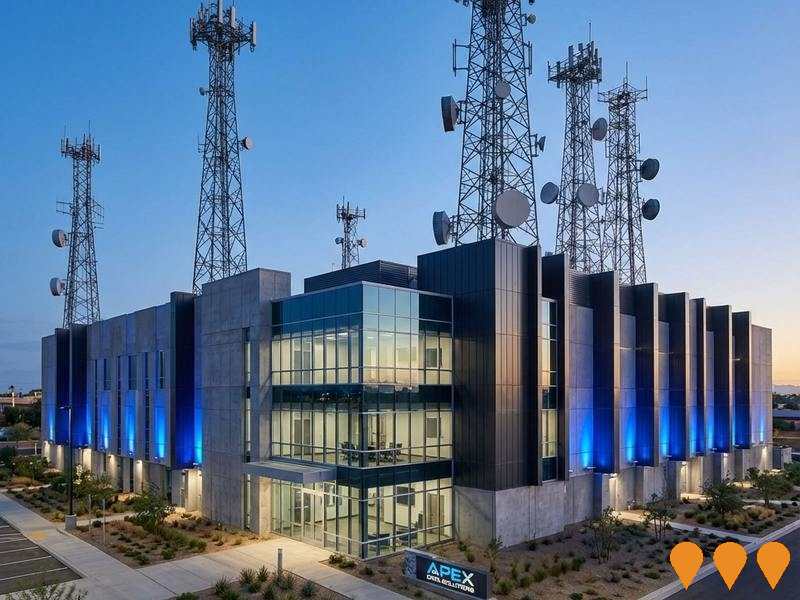Chart Color Schemes
est. as @ -- *
ABS ERP | -- people | --
2021 Census | -- people
Sales Activity
Curious about local property values? Filter the chart to assess the volume and appreciation (including resales) trends and regional comparisons, or scroll to the map below view this information at an individual property level.
Find a Recent Sale
Sales Detail
Population
Broken Hill has shown very soft population growth performance across periods assessed by AreaSearch
As of August 2025, Broken Hill's population is approximately 17,563, a decrease of 25 people from the 2021 Census figure of 17,588. This decline, representing a 0.1% change, is inferred from the estimated resident population of 17,541 in June 2024 and an additional 9 validated new addresses since the Census date. The population density is around 103 persons per square kilometer. Over the past decade, Broken Hill has shown resilient growth patterns with a compound annual growth rate of -0.6%, outperforming its SA3 area. Overseas migration was the primary driver of population gains during this period. AreaSearch uses ABS/Geoscience Australia projections for each SA2 area, released in 2024 with a base year of 2022, and NSW State Government's SA2 level projections for areas not covered by this data, released in 2022 with a base year of 2021.
Growth rates by age group are applied to all areas from 2032 to 2041. According to these projections, the area's population is expected to decrease by 4,161 persons by 2041. However, specific age cohorts like the 85 and over group are projected to grow, with an increase of 102 people anticipated.
Frequently Asked Questions - Population
Development
The level of residential development activity in Broken Hill is very low in comparison to the average area assessed nationally by AreaSearch
Broken Hill has received approximately six dwelling approvals annually. Over the past five financial years, from FY21 to FY25, 33 homes were approved, with an additional two approved in FY26 so far. Despite population decline, housing supply has remained adequate relative to demand, resulting in a balanced market with good buyer choice.
The average value of new homes being built is $434,000, aligning with regional patterns. This year, commercial approvals totaling $24.7 million have been registered, indicating balanced commercial development activity. Compared to the Rest of NSW, Broken Hill records about three-quarters the building activity per person. Nationally, it places among the 8th percentile of areas assessed, leading to relatively constrained buyer choice and supporting interest in existing dwellings.
This level is below the national average, suggesting the area's established nature and potential planning limitations. All recent development in Broken Hill has been comprised of detached houses, preserving its low density nature and attracting space-seeking buyers. With an estimated 3814 people per dwelling approval, it reflects a quiet, low activity development environment. Population projections indicating stability or decline suggest reduced housing demand pressures, benefiting potential buyers.
Frequently Asked Questions - Development
Infrastructure
Broken Hill has limited levels of nearby infrastructure activity, ranking in the 12thth percentile nationally
Changes to local infrastructure significantly impact an area's performance. AreaSearch identified five projects likely to affect this region. Key projects are: Broken Hill Health Service Redevelopment - MHIPU, ED Upgrade and Key Worker Accommodation, Silver City Energy Storage Centre (Hydrostor A-CAES), Broken Hill Town Square Redevelopment, and Broken Hill Community Health Centre.
Professional plan users can use the search below to filter and access additional projects.
INFRASTRUCTURE SEARCH
 Denotes AI-based impression for illustrative purposes only, not to be taken as definitive under any circumstances. Please follow links and conduct other investigations from the project's source for actual imagery. Developers and project owners wishing us to use original imagery please Contact Us and we will do so.
Denotes AI-based impression for illustrative purposes only, not to be taken as definitive under any circumstances. Please follow links and conduct other investigations from the project's source for actual imagery. Developers and project owners wishing us to use original imagery please Contact Us and we will do so.
Frequently Asked Questions - Infrastructure
Broken Hill Health Service Redevelopment - MHIPU, ED Upgrade and Key Worker Accommodation
Major health infrastructure project including a new purpose-built 8-bed Acute Mental Health Inpatient Unit (MHIPU), a $12 million Emergency Department (ED) upgrade with full internal refurbishment, and 20 new key worker accommodation units. Stage 2 of the ED upgrade was completed in July 2025, with the final stage currently underway and expected to be completed in late 2025. The new Acute MHIPU is open, providing modern mental health facilities for the Far West community. The 20 new key worker accommodation units are also complete, adjacent to the hospital campus to assist in recruiting and retaining healthcare workers. The overall redevelopment is being delivered by Health Infrastructure as part of the NSW Government's commitment to enhancing health services.
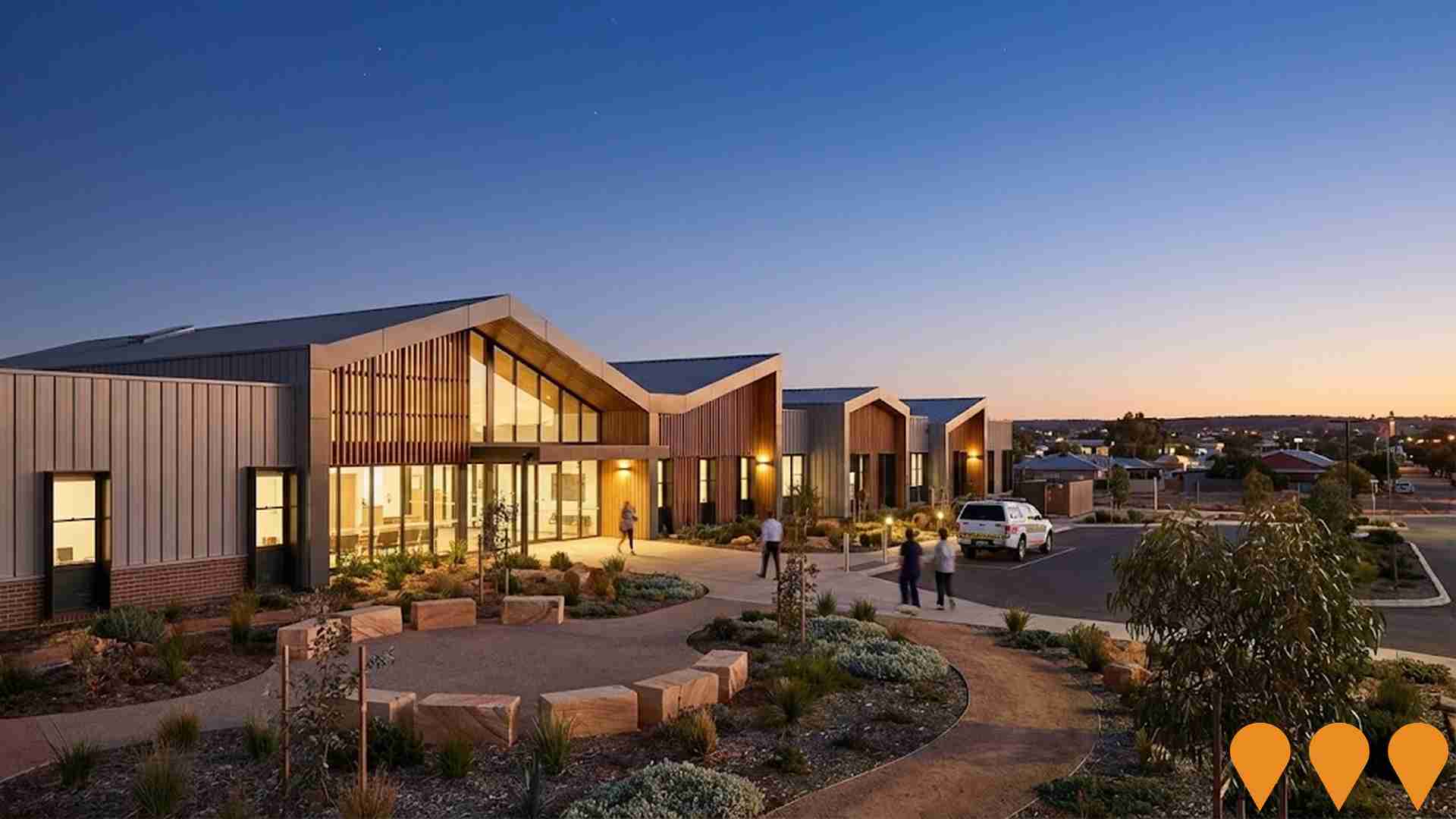
Broken Hill Community Health Centre
Integrated community health centre delivered as part of the Broken Hill Health Service Redevelopment. The facility includes a five-chair dental health clinic, child and family/community health services and new staff offices. Works also reconfigured parts of the main hospital's ambulatory care wing.

Silver City Energy Storage Centre (Hydrostor A-CAES)
A 200 MW / 1,600 MWh Advanced Compressed Air Energy Storage (A-CAES) facility that will repurpose underground workings at the disused Potosi mine near Broken Hill. The plant will provide more than 8 hours of long duration storage, form the backbone of a mini grid for Broken Hill, and replace ageing diesel generators while supporting new wind and solar generation in western NSW. The project secured NSW Government planning approval in February 2025 and is moving toward a three to four year construction program.

Murray River to Broken Hill Water Pipeline
270 km bulk water pipeline from the Murray River (Wentworth) to the Mica Street WTP at Broken Hill. Delivers up to ~37 ML/day with multiple pump stations and bulk storage, securing long term water supply for Broken Hill and nearby communities. Built for WaterNSW; operations and maintenance delivered under a JV including John Holland and TRILITY.

NSW Renewable Energy Zones (REZ) Program
NSW is delivering five Renewable Energy Zones (Central-West Orana, New England, South West, Hunter-Central Coast and Illawarra) to coordinate new wind and solar generation, storage and high-voltage transmission. The program is led by EnergyCo NSW under the Electricity Infrastructure Roadmap. Construction of the first REZ (Central-West Orana) transmission project commenced in June 2025, with staged energisation from 2028. Across the program, NSW targets at least 12 GW of new renewable generation and 2 GW of long-duration storage by 2030.
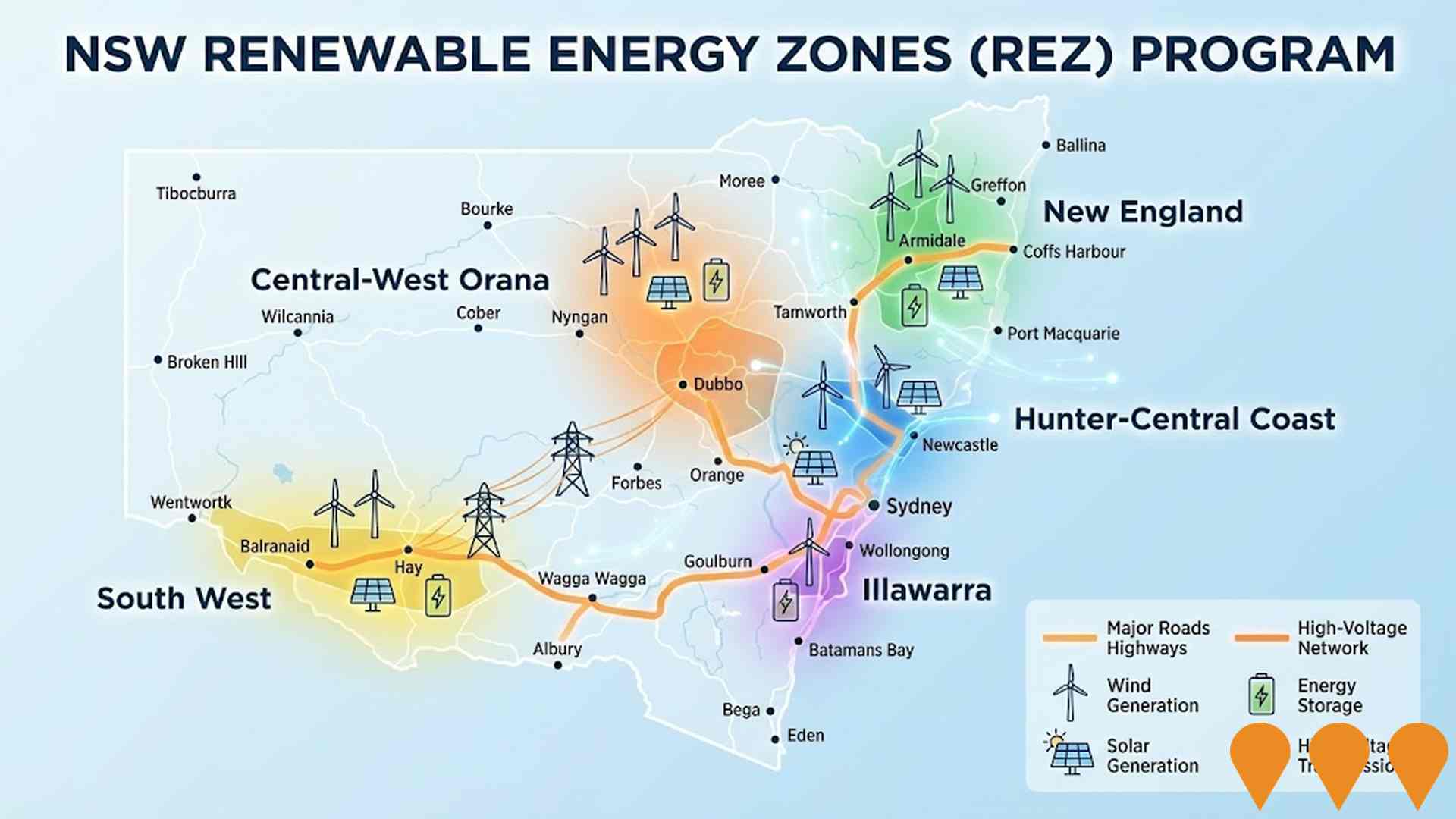
Enabling Infrastructure for Hydrogen Production
Australia has completed the National Hydrogen Infrastructure Assessment (NHIA) to 2050 and refreshed its National Hydrogen Strategy (2024). The programmatic focus has shifted to planning and enabling infrastructure through measures such as ARENA's Hydrogen Headstart and the Hydrogen Production Tax Incentive (from April 2025). Round 2 of Hydrogen Headstart consultation occurred in 2025. Collectively these actions aim to coordinate investment in transport, storage, water and electricity inputs linked to Renewable Energy Zones and priority hubs, supporting large-scale renewable hydrogen production and future export supply chains.
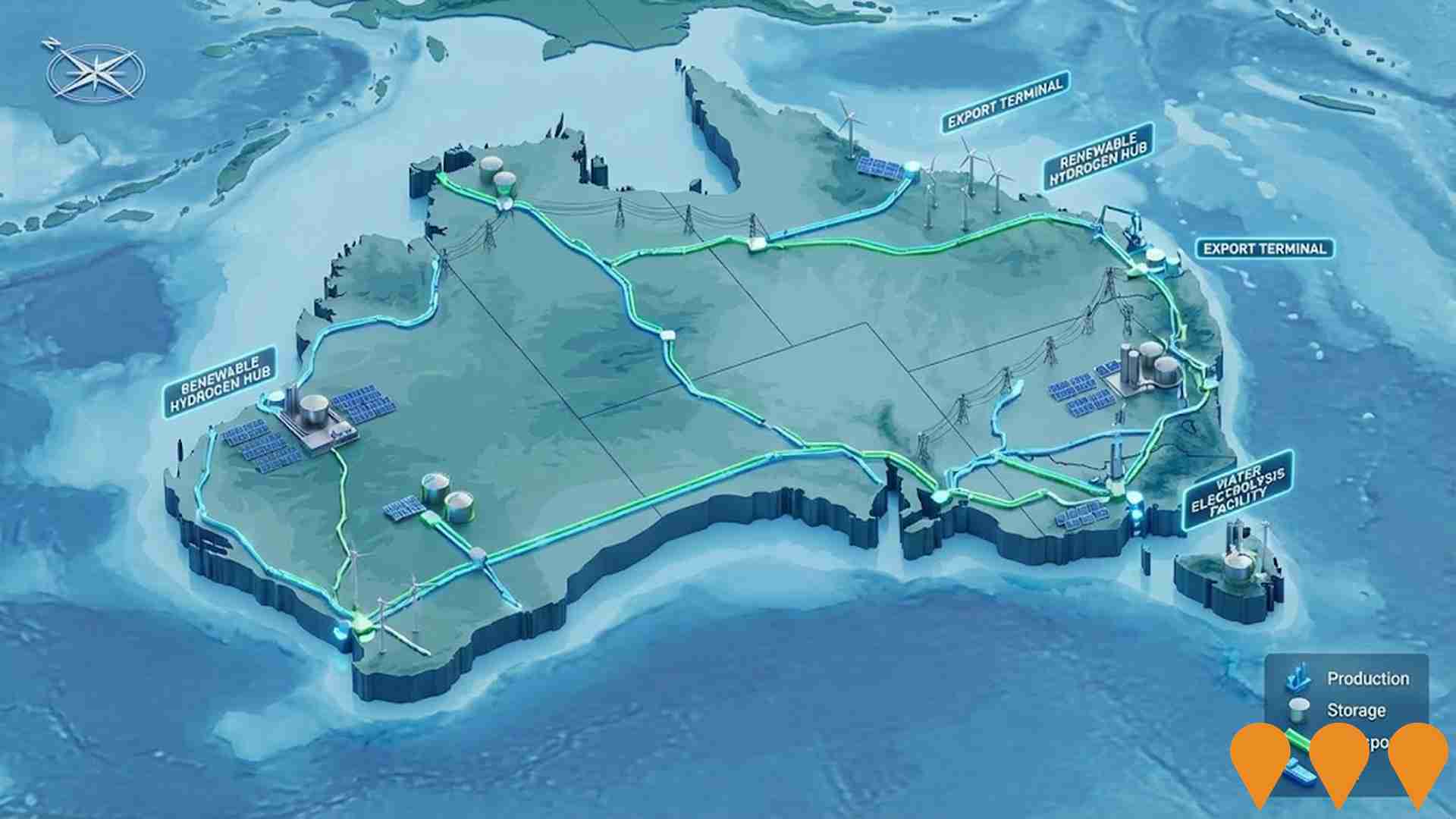
Silverton Wind Farm
199 MW onshore wind farm with 58 GE 3.x turbines located on the Mundi Mundi and Mount Robe Ranges in far west NSW. Fully commissioned in 2020. Operations of the wind farm transferred from AGL to Tilt Renewables in 2024 under long term arrangements. Generates around 780,000 MWh per year.
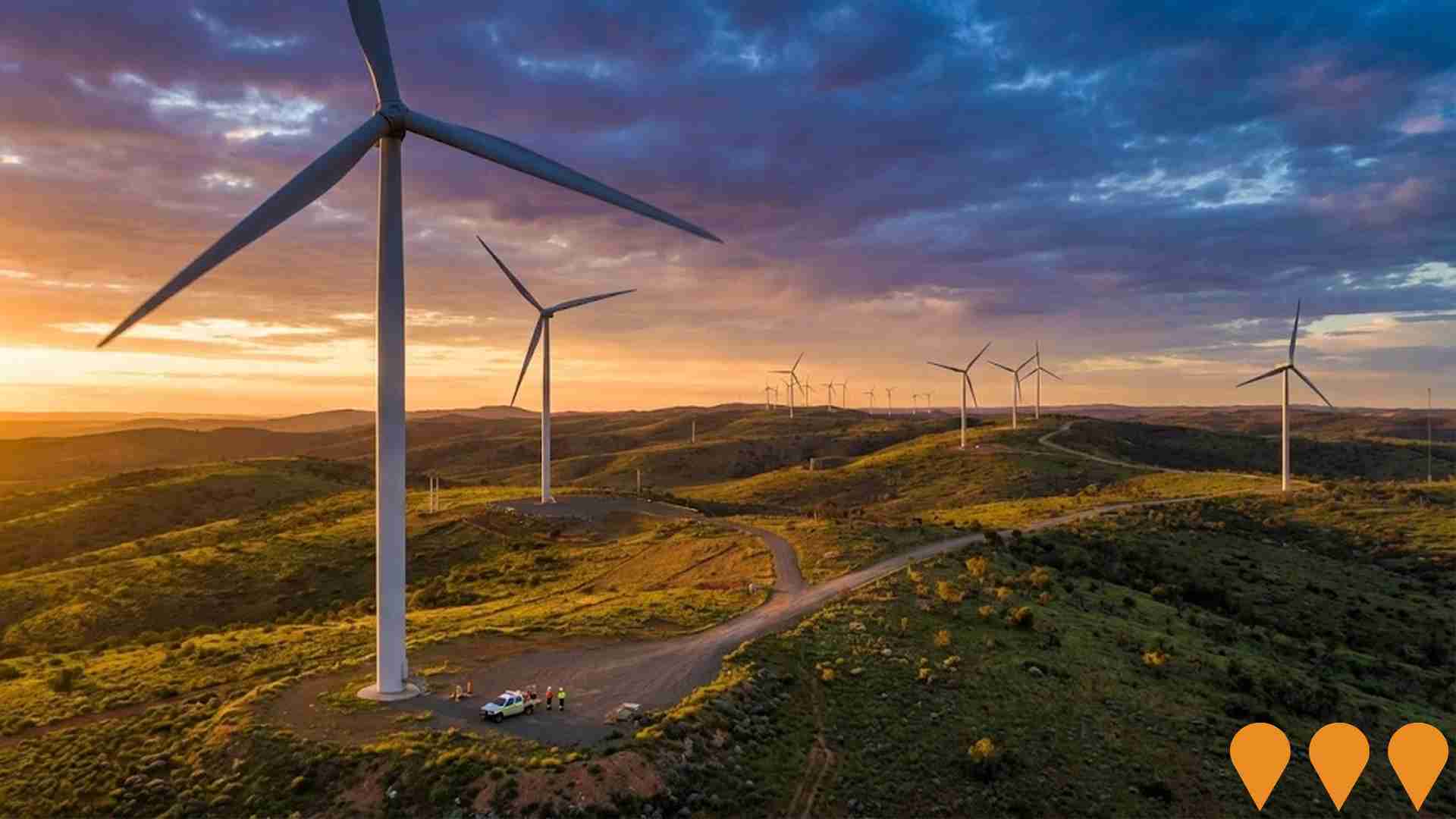
Bulk Water Supply Security
Nationwide program led by the National Water Grid Authority to improve bulk water security and reliability for non-potable and productive uses. Activities include strategic planning, science and business cases, and funding of state and territory projects such as storages, pipelines, dam upgrades, recycled water and efficiency upgrades to build drought resilience and support regional communities, industry and the environment.

Employment
Broken Hill shows employment indicators that trail behind approximately 70% of regions assessed across Australia
Broken Hill's workforce is balanced across white and blue-collar jobs, with prominent essential services sectors. As of June 2025, its unemployment rate is 4.4%.
The local employment rate stands at 7,326 residents, which is 0.7% higher than Rest of NSW's rate of 3.7%. Workforce participation in Broken Hill is lower at 52.0%, compared to Rest of NSW's 56.4%. Key industries include health care & social assistance, mining, and retail trade. Mining is particularly strong, with an employment share 4.6 times the regional level.
Conversely, agriculture, forestry & fishing is under-represented at 1.0% compared to Rest of NSW's 5.3%. Some residents commute for work outside Broken Hill. Between June 2024 and June 2025, Broken Hill's labour force decreased by 1.8%, with employment declining by 3.2%, leading to a 1.5 percentage point rise in unemployment rate. In contrast, Rest of NSW saw a 0.1% employment drop, a 0.3% labour force expansion, and a 0.4 percentage point unemployment increase. Jobs and Skills Australia's national employment forecasts from May 2025 project a 6.6% growth over five years and 13.7% over ten years nationally. Applying these projections to Broken Hill's employment mix suggests local growth of approximately 6.5% over five years and 13.9% over ten years, although these are simple extrapolations for illustrative purposes only.
Frequently Asked Questions - Employment
Income
Income levels sit below national averages according to AreaSearch assessment
AreaSearch's latest postcode level ATO data for financial year 2022 shows median income in Broken Hill is $51,977 and average income is $62,526. This contrasts with Rest of NSW's median income of $49,459 and average income of $62,998. Based on Wage Price Index growth of 12.61% since financial year 2022, estimated incomes as of September 2025 are approximately $58,531 (median) and $70,411 (average). Census 2021 income data indicates Broken Hill's household, family, and personal incomes fall between the 11th and 19th percentiles nationally. The earnings profile shows 27.2% of locals earn between $400 - $799, unlike regional trends where 29.9% earn between $1,500 - $2,999. Housing costs are modest with 90.0% of income retained, ranking total disposable income at the 18th percentile nationally.
Frequently Asked Questions - Income
Housing
Broken Hill is characterized by a predominantly suburban housing profile, with ownership patterns similar to the broader region
Broken Hill's dwelling structures, as per the latest Census, consisted of 94.9% houses and 5.1% other dwellings (semi-detached, apartments, 'other' dwellings). This is comparable to Non-Metro NSW's figures of 94.9% houses and 5.1% other dwellings. Home ownership in Broken Hill was at 43.9%, similar to Non-Metro NSW, with the remaining dwellings either mortgaged (31.3%) or rented (24.8%). The median monthly mortgage repayment in the area was $867, aligning with Non-Metro NSW's average, while the median weekly rent figure was $220, compared to Non-Metro NSW's $205. Nationally, Broken Hill's median monthly mortgage repayments were significantly lower than the Australian average of $1,863, and rents were substantially below the national figure of $375.
Frequently Asked Questions - Housing
Household Composition
Broken Hill features high concentrations of lone person households, with a fairly typical median household size
Family households constitute 60.6% of all households, including 19.3% couples with children, 26.0% couples without children, and 14.2% single parent families. Non-family households account for the remaining 39.4%, with lone person households at 37.1% and group households comprising 2.2% of the total. The median household size is 2.2 people, which aligns with the average in the Rest of NSW.
Frequently Asked Questions - Households
Local Schools & Education
Broken Hill faces educational challenges, with performance metrics placing it in the bottom quartile of areas assessed nationally
The area's university qualification rate is 13.5%, significantly lower than the NSW average of 32.2%. This disparity presents both a challenge and an opportunity for targeted educational initiatives. Bachelor degrees are most common at 9.3%, followed by postgraduate qualifications (2.2%) and graduate diplomas (2.0%). Trade and technical skills are prominent, with 38.6% of residents aged 15+ holding vocational credentials – advanced diplomas (7.9%) and certificates (30.7%).
Educational participation is high at 27.9%, including 10.6% in primary education, 7.6% in secondary education, and 2.7% pursuing tertiary education. A network of 10 schools operates within Broken Hill, educating approximately 2,551 students. This includes 8 primary schools and 2 secondary schools serving distinct age groups.
Frequently Asked Questions - Education
Schools Detail
Nearby Services & Amenities
Transport
Transport servicing is low compared to other areas nationally based on assessment of service frequency, route connectivity and accessibility
Broken Hill has 92 active public transport stops, serving a mix of train and bus services. These stops are covered by 18 individual routes, offering a total of 1,046 weekly passenger trips. The city's transport accessibility is rated good, with residents typically located 226 meters from the nearest stop.
Service frequency averages 149 trips per day across all routes, resulting in approximately 11 weekly trips per stop.
Frequently Asked Questions - Transport
Transport Stops Detail
Health
Health performance in Broken Hill is a key challenge with a range of health conditions having marked impacts on both younger and older age cohorts
Broken Hill faces significant health challenges affecting both younger and older age groups.
Approximately 51% (~8,974 people) have private health cover, slightly lower than the average SA2 area. The most prevalent medical conditions are arthritis (12.0%) and asthma (10.2%), with 56.6% of residents reporting no medical ailments, compared to 57.9% in Rest of NSW. As of 2016, 23.7% (~4,167 people) are aged 65 and over. Seniors' health outcomes present challenges broadly mirroring the general population's profile.
Frequently Asked Questions - Health
Cultural Diversity
The latest Census data sees Broken Hill placing among the least culturally diverse areas in the country when compared across a range of language and cultural background related metrics
Broken Hill has a cultural diversity index below the average, with 89.1% of its population being Australian citizens, 94.3% born in Australia, and 96.3% speaking English only at home. Christianity is the predominant religion in Broken Hill, comprising 43.8% of the population, compared to 44.9% across the rest of NSW. The top three ancestry groups are Australian (34.2%), English (29.9%), and Australian Aboriginal (7.3%).
Notably, Maltese (1.2%) and Filipino (1.1%) populations are slightly higher than regional averages of 1.1% and 1.0%, respectively.
Frequently Asked Questions - Diversity
Age
Broken Hill hosts an older demographic, ranking in the top quartile nationwide
Broken Hill's median age is 44 years, similar to the Rest of NSW's 43 and above the national average of 38 years. Compared to the Rest of NSW, Broken Hill has a higher percentage of residents aged 25-34 (12.9%) but fewer residents aged 45-54 (10.2%). Between the 2021 Census and now, the population aged 35-44 has grown from 10.7% to 11.8%, while the 55-64 age group has declined from 14.6% to 13.0% and the 45-54 age group has dropped from 11.4% to 10.2%. By 2041, Broken Hill's age composition is expected to change significantly. The number of residents aged 85 and over will grow by 22%, reaching 654 from 535. This demographic aging trend means that residents aged 65 and older will represent all the anticipated growth. Conversely, both the 0-4 and 45-54 age groups are expected to decrease in number.



